New Battleground Polls Show Slight Romney Surge
Romney's post-debate surge is being picked up in swing state polls, but will it be enough?
A week out from the first Presidential debate, Mitt Romney seems to have solidly surged in the national polls. Just looking at the numbers this morning, we see Romney with a slight one point lead in the new Fox News poll, a one point lead in the Rasmussen Daily Tracking poll, a five point lead in the IBD/TIPP Tracking Poll (a new addition to RCP’s poll average in the last several days), and a tie in the Gallup Daily Tracking Poll. Combined with previous polls, this leaves Romney with a +1,5 lead in the RealClearPolitics average. As James Joyner noted yesterday, though, it didn’t seem as though Romney’s surge in the national polls was filtering down to the state level in a manner that would allow him to over take the President’s rather comfortable lead in the Electoral College. This morning, we’ve got two sets of battleground state polls that do show Romney picking up steam at the state level, but they also show that the President still has a significant advantage in the states that are going to decide this election.
Up first is a new round of polling from NBC News and Marist College of Florida, Ohio, and Virginia:
A week after President Barack Obama’s lackluster debate performance, Republican challenger Mitt Romney has made some gains in three key swing states among those most likely to vote, according to the latest round of NBC News/Wall Street Journal/Marist polls.
Romney and Obama remain in a virtual tie in Virginia and Florida, and the Democratic incumbent maintains a slight advantage in Ohio.
Romney saw his largest gain in Virginia, where he now edges the president 48 percent to 47 percent, a 3-point reversal from last week’s poll, released the day of the first presidential debate. The spread is within the poll’s margin of error.
In Florida, before the debate, it was a 1-point race with Obama leading 47 percent to 46 percent. Now, it is still a 1-point race with Obama leading 48 percent to 47 percent.
In Ohio, where there has been a renewed focus by the Romney campaign after the former Massachusetts governor’s strong debate performance, Obama leads 51 percent to 45 percent. That’s a 2-point uptick for Romney.
But the Ohio poll also included an 11-point advantage for self-described Democrats — 40 percent to 29 percent for Republicans. Last week’s poll had a narrower 5-point advantage for Democrats. . (In 2008, the party identification split was 39 percent Democrat and 31 percent Republican, according to exit polls.)
One factor that may have pulled the party ID more heavily toward Democrats in this poll was early voting. One-in-five respondents (18 percent) said they have already voted, and, of those, almost two-thirds (63 percent) said they voted for Obama.
The ideological makeup in this poll was 22 percent liberal, 32 percent moderate, 46 percent conservative, which is actually less moderate and more conservative than four years ago when it was 20 percent liberal, 45 percent moderate, and just 35 percent conservative, according to the exit poll.
When early voters are taken out of the equation, Obama’s lead shrinks to 48 percent vs. Romney’s 46 percent.
(…)
In all three states, the overwhelming majority of voters said they made up their minds before the debate — 92 percent in Florida and Ohio, and 91 percent in Virginia. Just 7 percent in Virginia, 6 percent in Florida, and 5 percent in Ohio said they decided after the debate. But in all three states, Romney won them.
“The debate helped Romney but most voters had already picked sides,” Carvalho added.
Those two highlighted points may end up being Romney’s biggest problem in states like Ohio. The amount of people who are undecided is incredibly small, much smaller than I’ve seen in previous elections with four weeks still left to go before Election Day. While the conventional wisdom is that undecided voters break for the challengers, this is not necessarily true when you actually look at the facts. Quite often, you’ll see these undecideds breaking for the incumbent and sometimes they just end up not voting at all. In states where the margin between the two candidates is as narrow as it is in these three states, Romney would need to capture virtually all of the undecided voters and make sure they get out to vote, not an easy task. Add into this the early voters, which seem to be strongly favoring Obama in Ohio right now at the very least, and the task becomes even more daunting. Those early votes, after all, are already in the can and those voters aren’t only not persuadable, they’re at the point where what happens in the election from now on is largely irrelevant to them. Four years ago, more than one-third of the votes cast in Iowa and Ohio were cast via early voting or absentee ballots, and the President won both states. If the pattern continues this year, then Romney could find himself locked out.
The second round of polling today comes from CBS News and Quinnipiac University:
On the heels of last week’s presidential debate, Mitt Romney has emerged with a one-point edge over President Obama in Colorado and has cut the president’s lead in half in Wisconsin, according to a new Quinnipiac University/CBS News/New York Times poll.
In Wisconsin, where Mr. Obama led Romney by six percent last month, the president now holds just a three-point advantage, with 50 percent to Romney’s 47 percent support. Last month, the president led Romney 51 to 45 percent.
In Colorado, the two remain locked in a dead heat, with Romney leading Mr. Obama 48 percent to 47 percent, within the poll’s margin of error. Last month, also within that margin, Mr. Obama had the one-point edge, with 48 percent to Romney’s 47 percent.
In Virginia, the presidential race remains essentially unchanged, with Mr. Obama holding on to a small lead over Romney, with 51 percent support to Romney’s 46. In September, the president led Romney 50 percent to 46 percent there.
All three polls, conducted from October 4-9, began surveying voters after the first presidential debate.
The debate had a positive impact on voters’ impressions of Romney. More than four in ten voters in these states who watched the first presidential debate (and 51 percent in Colorado) say it made them feel better about Romney. Fewer than one in 10 said that about Mr. Obama; more say it made them think worse of him.
Among voters who say the debate will impact their vote, the advantage goes to Romney. Even though majorities in these battlegrounds say the debate will have no effect on their vote, twice as many voters said the debate would make them more likely to vote for Romney than said so of Mr. Obama. Among independent voters, about half in these battleground states say the debate gave them a better impression of Romney, and about a quarter in each state say it made them more likely to vote for him.
Romney made gains among voters who are paying a lot of attention to the presidential campaign. Among these voters, Romney leads in Colorado by 53 percent to 44 percent, and in Wisconsin he leads by a smaller margin (51 percent to 47 percent). When measuring voters who have been paying close attention, the race becomes even in Virginia, 49 percent to 49 percent.
Republicans continue to be more enthusiastic than Democrats about voting this year in general. More than half of Republicans in Colorado and Wisconsin are more enthusiastic about voting in this election; this is true of just over a third of Democrats. In Virginia, the enthusiasm gap is narrower, with 48 percent of Republicans and 40 percent of Democrats identifying as more enthusiastic about voting this year.
Diving deeper into the poll, we find that Romney has improved his numbers in these states in several important areas, including leadership, ability to handle the economy, and other issues. Clearly, the debate has improved his position with voters, although it interestingly does not seem to have had a serious negative impact on the President’s underlying numbers. This suggests that the stage is set for a rebound in Obama’s topline numbers if the conditions are right. The best opportunity for that, of course, will be next’s “Town Hall” debate. I tend to doubt that tonight’s Vice-Presidential will have much of an impact on the numbers either nationally in the swing states, though.
Each of these states is now pretty much a toss-up. In Ohio, the President has a slim 1.6 point lead in the RearClearPolitics poll average, far below the 4-5 point lead he had just a few weeks ago. In Florida, the race is now tied and the 2-3 point lead that the President had is gone. In Virginia, another state where the President once had a fairly strong lead, we now have a +0.6 point lead for the President thanks to Romney’s uptick in support. Colorado, where the President was leading for most of the campaign to day, we have a state where Mitt Romney has a slight +0.6 point lead in the poll average. Finally, in Wisconsin, which had seemed to slip out of Republican hands after a slight bump after the selection of Paul Ryan, we have a +2.3 point lead for the President and a race that is narrowing quite quickly.
Looking at the pre-debate benchmarks I posted last week, it’s fairly clear that we’ve seen a significant change in the race. The national poll numbers that just a week ago showed the President with a statistically significant lead and a trend that seemed to be very much in his favor have now changed to show the polls as tight as they were before the convention and, for the first time, a small lead for Mitt Romney. On the Electoral College level, Obama does still continue to hold an advantage, but it’s significantly below where it was a week ago largely because several states that were on Obama’s side have slipped into the “Toss up” category. Some of these, such as Pennsylvania and Michigan, strike me as implausible ones for Romney, though, and I expect to see them back in the President’s column in the near future. It’s significant that there has yet to be a transition of any of these states into Romney’s column; he’s been stuck at 181 Electoral Votes in RCP’s estimate for weeks now. If Romney is going to have a path to Electoral College victory, he’s got to begin gaining support in the swing states at much quicker pace than he has been so far.
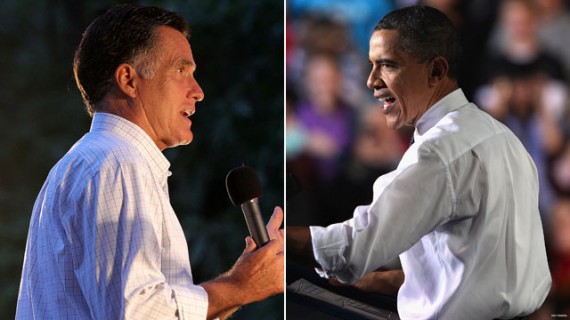

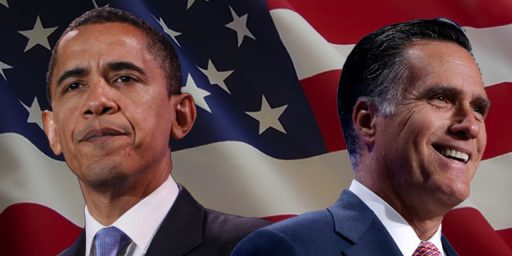
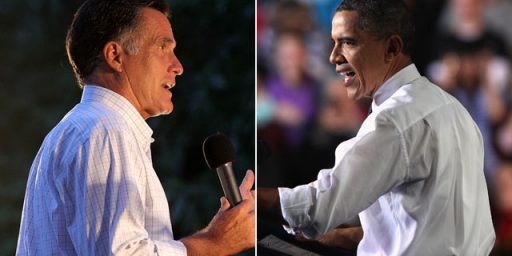
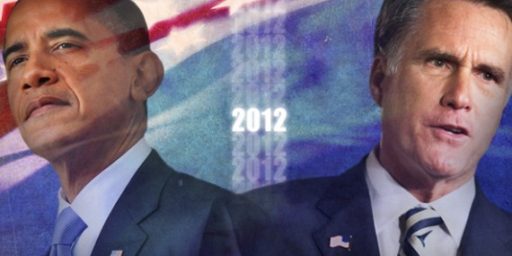
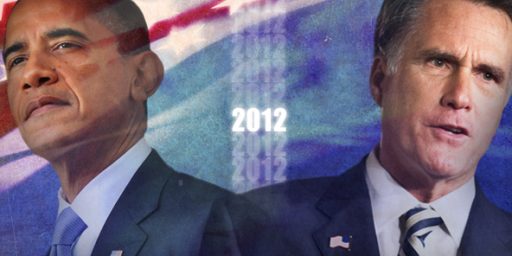
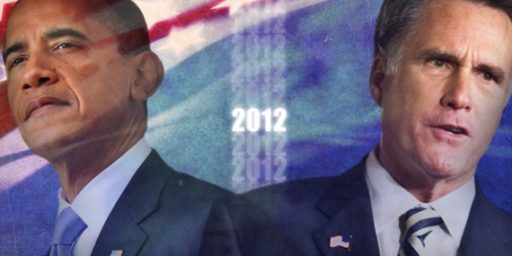
Slight? Was Katrina a “slight” thunderstorm?
I always thought the race was going to tighten up, but Romney’s debate performance has certainly increased his chance to win. Unfortunately.
The real question–nationally and especially at the state level: is this as good as it’s going to get for Mitt Romney?
Those Ohio numbers re: early voters are eye-popping, and lead me to believe that the ground games there are still not evenly matched.
I would have to guess that any late break towards Romney amongst undecideds would be counterbalanced by Obama’s superior GOTV operation.
I don’t see this as an erosion of Obama support as much as a consolidation of Romney’s voters. Romney has been able to tighten up his GOP support, plus increased his support level (which can be a big boost in a likely voter screen — moving a 6 to a 7 is a big deal.) This was always going to be a dog fight, but Romney still has the difficult path of getting to 270 in the EVs, and this is after what is clearly the worst week that Obama has had in many months.
One thing that strikes me as significant is the overwhelming edge that Obama seems to have in Ohio among those who have already voted. That says a lot about ground game and those votes are inthe book. Expect GOP has a good ground game too stories to start flooding the media soon.
Can the truth prevail?
WHAT EVERYBODY NEEDS TO KNOW ABOUT ROMNEY’ $5 TRILLION TAX CUT PROMISES
Or is this really a post-truth “surge” and election?
Hold the presses.
As of this morn, Obama has surged back into the lead in the Rasmussen daily tracking poll. If I recall correctly, that puts him where he was before the debate with them.
So Romney scored the biggest debate win in history…and still has an almost impossible route to the Presidency?
This should help:
http://nymag.com/daily/intel/2012/10/paul-ryan-weight-photo-time-p90x.html
Romney had his strongest national polling day yet today though–Gallup, Monmouth, and UPI all show him up, with only Rasmussen tipping towards Obama.
If the Obama campaign figures out how to goose Democratic enthusiasm and get its mojo back, the national numbers could come back. National numbers seem to be more volatile as the race is much more crystalized in battleground states where the information cycle is way ahead of non-battleground states–more ads, more focus on the race, people making their minds up sooner.